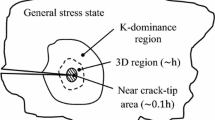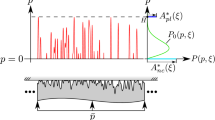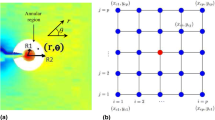Abstract
A numerical procedure for contact analysis and calculating subsurface stress was developed. The procedure takes the advantage of signal processing technique in frequency domain to achieve shorter computing time. Boussinesq’s equation was adopted as a response function in contact analysis. The validity of this procedure was proved by comparing the numerical results with the exact solutions. The fastness of this procedure was also compared with other algorithm.
Similar content being viewed by others
References
Anderson, T., 1982, “The Second Generation Boundary Element Contact Problem,” Boundary elements in Engineering,Proceedings of Forth International Seminar, Southampton, England,
Bailey, D. M., and Sayles R. S., 1991, “Effect of Roughness and Sliding Friction on Contact Stresses,”ASME Journal of Tribology, Vol. 113, pp. 729–738.
Bush, A. W., Gibson, R. D. and Thomas, T. R., 1975, “The Elastic Contact of a Rough Surface,”Wear, Vol. 35, pp. 87–111
Greenwood, J. A., and Williamson, J. B. P., 1966, “Contact of Nominally Flat Surfaces,”Proceedings of the Royal Society of London, Vol. A295, pp. 300–319.
Hertz, H., 1882 “Über die Ber hrung fester elastischer Körper,”J. reine und angewandte Mathematik, Vol. 92, pp. 156–171
Johnson, K. L., 1985, “Contact Mechanics,” Cambridge University Press
Ju, Y., and Farris, T. N., 1996, “Spectral Analysis of Two-Dimensional Contact Problems,”ASME Journal of Tribology, Vol. 118, pp. 320–328.
Kwak, B. M., 1990, “Numerical Implement of Mechanical Engineering,”KSME Iournal, Vol. 4, No. 1, pp. 23–31
Kalker, J. J., and van Randen, Y., 1972, “A Minimum Principle for Frictionless Elastic Contact with Application to Non-Hertzian Half Space Contact problems,”J. of Eng. Math., Vol. 6, pp. 193–206
Komvopoulous, K. and Choi, D. H., 1992, “Elastic Finite Element Analysis of Multi-Asperity Contact,”ASME Journal of Tribology, Vol. 114, pp. 823–831
Lai, W. T. and Cheng, H. S. 1985, “Computer Simulation of Elastic Rough Contacts,”ASLE Transaction, Vol. 28, pp. 172–180.
Love, A. E. H., 1929, “The Stress Produced in a Semi-infinite Solid by Pressure on Part of the Boundary,”Phil. Trans. Royal Society, Vol. A228, pp. 377–420.
Lunderberg, G. and Sj vall, H. 1958, “Stress and Deformation in Elastic Solids,” Pub. No. 4 Inst. Th. of Elast., Chalmers University of Technology, Göteborg, Sweden which is referred in “Contact mechanics” by Johnson, K. L., (1985)
Ren, N., and Lee, S. C., 1993, “Contact Simulation of Three-Dimensional Rough Surfaces Using Moving Grid Method,”ASME Journal of Tribology, Vol. 115, pp. 597–601.
Stanley, H. M., and Kato, T., 1997, “An FFT-Based Method for Rough Surface Contact,”ASME Journal of Tribology, Vol. 119, pp. 481–485.
Suh, N. P., 1977, “An Overview of the Delamination Theory of Wear,”Wear, Vol. 44, pp. 1–16.
Tian, X., and Bhushan, B., 1996, “A Numerical Three-Dimensional Model for the Contact of Rough Surfaces by Variational Principle,”ASME Journal of Tribology, Vol. 118, pp. 33–42.
Webster, M. N., and Sayles, R. S., 1986, “A Numerical Model for the Elastic Frictionless Contact of Real Surfaces,”ASME Journal of Tribology, Vol. 108, pp. 314–320
Westergaard, H. M., 1939, “Bearing Pressures and Cracks,”ASME Journal of Applied Mechanics, Vol. 6, pp. A49-A53.
Author information
Authors and Affiliations
Corresponding author
Rights and permissions
About this article
Cite this article
Cho, YJ., Koo, YP. & Kim, TW. A new FFT technique for the analysis of contact pressure and subsurface stress in a semi-infinite solid. KSME International Journal 14, 331–337 (2000). https://doi.org/10.1007/BF03186426
Received:
Revised:
Issue Date:
DOI: https://doi.org/10.1007/BF03186426




